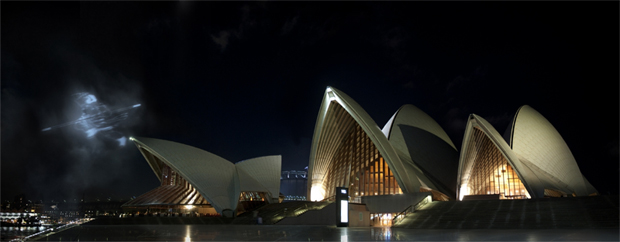Behind Sydney's Biennale: artful tech

While the spirit of "classic" art — championed by the Mona Lisa, Michelangelo's David and the paintings of Vincent Van Gogh — is being kept alive and well today, more and more artists are turning to digital mediums, backed by IT, to communicate ideas to their audiences.
Sydney Biennale is one of Australia's largest (if not the largest) exhibitions of contemporary, new and digital art. Showcasing more than 440 works by 166 artists from 36 countries, it will be the largest exhibition staged in the 37-year history of the Biennale.
ZDNet Australia delved into the technical side of the event with William Cottam, the finance and administration manager of the Biennale.
The art
Over 70 per cent of $4.5 million budgeted on artworks and installation is for audio visual and IT infrastructure, according to Cottam. (The total expenditure for the event, including office operations of the Sydney Biennale, is estimated at $9 million).
Cottam believes that this level of expenditure is not surprising considering that artworks (especially audio and video projections) are increasingly reliant on IT and technology.

New Adventure of Havoc in Heaven III (Credit: artist Jennifer Wen Ma,
photographed by Michael Corridore)
"You only need to walk through a gallery to see how IT driven modern art is," said Cottam, adding that new art forms like digital art (which are often based around data visualisation, computers and audience participation) are quite tech heavy.
One of the artworks, Jennifer Wen Ma's "New Adventures of Havoc in Heaven III", uses projections and smoke choreographed with a performer to show the dancing image of Sun Wukong, a famous figure in Chinese mythology.
Another artwork, "The Feast of Trimalchio" by Russian artist collective AES+F, is an epic nine screen, nine channel, digital collage comprising over 75,000 animated photographs. These are only two of the multitude of electronic and interactive artworks on display in the festival.
Generally, the workhorses of the Biennale's digital artworks include LCD screens, projectors, iMacs and PCs running 64-bit Windows XP. Works using QuickTime videos are synced using software called "Multiscreener". For projections, videos are run from servers using "Matrox Triplehead2Go Digital" video cards. This is in addition to the morass of lights, supports and other equipment often used to bring artworks to life.
Each venue for the Biennale has also been fitted with wireless internet and communications provided by Telstra.
"Sadly, it's not a sponsorship," said Cottam, adding that wireless plays an important role in delivering the audio tours and helping the Biennale headquarters in Woolloomooloo communicate with the Cockatoo island and Pier 2/3 sites.
While Telstra may not have provided its services pro bono, computer manufacturer Dell pitched in and provided the Sydney Biennale with free networking and laptops and fitted out a shipping container with notebook computers on Cockatoo Island as part of the Biennale's hub education initiative.
Not enough Monet for tech?
While Biennale shells out for the IT used for the artworks, the not-for-profit organisation has to make do with old, but reliable gear for its everyday operations. In Cottam's eyes, the Biennale organisation is very much at the tail end of technology adoption.
"Ideally we'd like to be out there and using the new stuff and being innovative, but it's really driven from an economical perspective," said Cottam, describing the Biennale organisation as a follower rather than a leader in adopting technology trends.
"All of our funding goes on our exhibition and quite often our funders and benefactors aren't really interested in our internal operations, so it ends up being the poor cousin of the exhibition itself."
It may be harsh, but according to Cottam it is driven by economic necessity and, understandably, the artworks have funding priority.
Local support
Being a small not-for-profit organisation means Cottam's company is unable to afford an internal IT support team. For the past year, the bulk of technical and IT support for the Biennale exhibition and its office operations was provided by Australian IT services company Dancrai, selected through a conventional tender process.
"[We chose Dancrai] mainly because of their commercial expertise, depth of the team, level of service," said Cottam, adding that he was pleased with the Australian IT company's performance and speed in fixing problems. A specialist audiovisual technician was also hired by the Sydney Biennale to provide additional technical support.
The Biennale also currently uses Salesforce to manage its body of over 300 volunteers, benefactors and other stakeholders.
"Basically, it's the tool we use to manage all our relationships, which has gone pretty well I've got to say," Cottam said.
Email is hosted internally in the office servers. So far the organisation hasn't found any major problems with the service, but Cottam said it is "definitely" open to the possibility of adopting cloud email, IP telephony and other technology in the future.
"When we get the breathing space we'll look into that kind of stuff and we'll be guided pretty well by Dancrai," said Cottam.
The Biennale has already embraced mobile technologies, joining up with Sydney-based mobile developer obii.mobi to create an iPhone app that allows users to upload their own iPhone-made video reviews on to a website.
Things may also be looking up for the organisation, with an equiptment grant application lodged to Perpetual Australia. If it's approved, perhaps we'll be seeing the Biennale's Woolloomooloo office decked out in smartphones and 30-inch cinema displays in the near future?
"I hope so," joked Cottam with a chuckle.